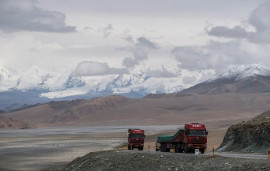
Today, there is a plethora of research available on the negative impact of building large dams. Not only are the poor whose lives depend on the river usually affected by the construction of large dams but also the ecosystem of the basin. According to the World Commission on Dams, the end of any dam project must result in sustainable improvement of human welfare, that is, it must be economically viable, socially equitable and environmentally sustainable.
Water storage capacity of big dams goes down
No doubt, dams play an important role in managing and applying water resources for various uses like agriculture, industrial and domestic use, and flood control and hydropower generation. Water debates between India and Pakistan, however, are more intricate and don’t inhibit the domain of just water-sharing wherein underlying cause of various conflicts, especially water conflict, is the fundamental absence of trust between the two countries. According to a report by the Institute of Peace in the US, ‘disagreement on the Baglihar dam project was not merely over technical specifications but was largely driven by Pakistan’s security concerns over India’s intentions to hold/restrict water during low-flow winter months and release excess water during high-flow summer months, was feared to cause flooding in that region of Pakistan’. In this sense, any action by India attracts suspicion in Pakistan, and vice versa.
Now, India’s plans to construct dams and reservoirs in the aftermath of the Uri attacks need to be seriously examined. If only the environmental or ecological cost of building dams is observed, the Indian forays into earlier dam constructions aren’t very promising for the region. For instance, the Sri Sailam dam across the River Krishna in Andhra Pradesh caused the submergence of some 106,925 acres of land across 117 villages in the region. Moreover, almost 27,000 families were displaced because of dam construction. In a similar way, “the Ukai Dam across the River Tapi in Gujarat displaced 52,000 people; the Pong Dam in Himachal Pradesh displaced nearly 100,000 people; and the Bhakra Dam displaced over 2,100 families.” Displacement, evacuation and submergence are the negative externalities of constructing large dams by India and the same trend is going in Jammu and Kashmir.
Furthermore, it is well recognised that most of the water conflicts between India and Pakistan are, in reality, conflicts over dams. For instance, the Baglihar Dam, constructed on the River Chenab and completed in 2008, has been a contentious issue between India and Pakistan due to its design and storage capacity. Similarly, the Kishanganga Dam on the River Jhelum is mired in controversy because of its river diversion plans. Now, just for the sake of argument even if Pakistan lets India build Kishanganga and Ratle dams, it can’t ignore topographic impacts on the region, putting water security issue aside for a moment. Therefore, a pre-requisite to initiating construction of dams and reservoirs in J&K is to gather ample understanding of its topography. Also, it is important to recognise that the state at present doesn’t have an adequate infrastructure (canals) to store water, which could potentially cause flooding in the state.
Only 76% of allocated funds spent on water projects
Hence, though Pakistan and India concluded the much-delayed water talks in the US capital, raising hopes that they would avoid further tensions over an issue that has far-reaching consequences for both; nevertheless, Pakistan should keep in mind all the above considerations before letting India execute plans for constructing dams over rivers in the Indus basin.
Published in The Express Tribune, August 28th, 2017.
Like Opinion & Editorial on Facebook, follow @ETOpEd on Twitter to receive all updates on all our daily pieces.






































COMMENTS (4)
Comments are moderated and generally will be posted if they are on-topic and not abusive.
For more information, please see our Comments FAQ